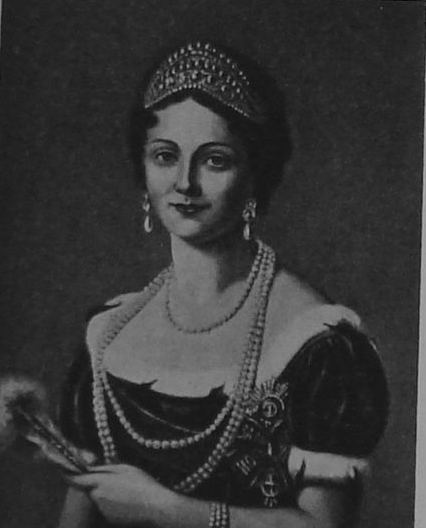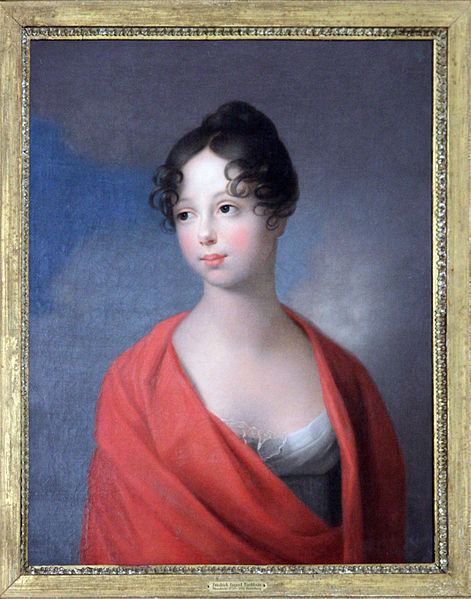Name Catherine of | ||
 | ||
Tenure 30 October 1816 – 9 January 1819 Issue Duke Alexander Georgievich of OldenburgDuke Peter Georgievich of OldenburgMaria, Countess of NeippergSophie, Queen of the Netherlands House House of OldenburgHouse of WurttembergHouse of Holstein-Gottorp-Romanov Mother Sophie Dorothea of Wurttemburg Children Sophie of Wurttemberg, Duke Peter Georgievich of Oldenburg Parents Paul I of Russia, Maria Feodorovna Siblings Alexander I of Russia, Nicholas I of Russia Similar People Alexander I of Russia, Maria Feodorovna, Paul I of Russia, Anna Pavlovna of Russia, Grand Duchess Alexandr | ||
Grand Duchess Catherine Pavlovna of Russia (Russian: Екатерина Павловна; 10 May 1788 – 9 January 1819) later Queen Catharina of Württemberg, was the fourth daughter of Tsar Paul I of Russia and Princess Sophie Dorothea of Württemberg. She became the Queen of Württemberg upon her marriage to her first cousin Crown Prince William who eventually became King William I of Württemberg in 1816.
Contents

Life

Ekaterina was born at Tsarskoye Selo and named after her grandmother, Catherine the Great. She had a happy childhood and her education was carefully supervised by her mother. Ekaterina received the best education and constantly furthered her education through reading new literary publications and personal contacts with various outstanding persons. Known as Katya in the family, She was very close to her siblings, particularly her eldest brother Tsar Alexander I. Throughout her life she would maintain a close relationship with him. It was said that she was Alexander's favorite sister and one of the few persons he loved unconditionally. His letters to her are expressed in phrases like "I am yours, heart and soul, for life", "I think that I love you more with each day that passes", and "to love you more than I do is impossible". Although Paul and Maria Feodorovna were initially disappointed at the birth of a fourth daughter, Ekaterina later became her mother's favorite daughter.

After Napoléon I's divorce from Empress Joséphine during the course of the Napoleonic Wars, the French Emperor hinted to Alexander I his wish to marry Ekaterina - a desire mainly to draw the Russians to his side. These plans had actually been hinted as early as 1808, in Erfurt, on suggestion by Talleyrand. Ekaterina's family was horrified, and so the Dowager Empress immediately arranged a marriage for her daughter to Duke George of Oldenburg.
Marriages
Described as beautiful and vivacious, Ekaterina was married to her first cousin Duke George of Oldenburg on 3 August 1809. Although their marriage was arranged, Ekaterina was devoted to her husband. George was the second son of Peter, Duke of Oldenburg and his wife, Duchess Frederica of Württemberg. It was said that he was not handsome but Ekaterina reportedly cared for him deeply and his death in 1812, due to typhoid fever, saddened her greatly. The couple resided in Tver, where George had been appointed governor general. Catherine lived a lavish court life and entertained with balls, grand dinners and similar events in the pattern of the Imperial court, to create "a Small Saint Petersburg" in Tver. She also supported N.M. Karamzin to write his later famous historical work. Tsar Alexander adopted reactionary ideas from a patriotic group which she dominated. In 1812, some conspirators who planned to depose Tsar Alexander had the ambitions to put her on the throne as Empress Catherine III.
In 1812, she supported the suggestion to summon a national militia, and formed a special regiment of chasseurs which took part in many of the great battles of the era. During 1813-1815, Ekaterina travelled to England with her brother Tsar Alexander I to meet the Prince Regent and again during the Vienna Congress. She was not without influence upon his political acts during these trips. She also supported the marriage between her youngest sister Anna and William II of the Netherlands.
In England, she met the Crown Prince William of Württemberg. It was love at first sight for the couple. However, William was married to Princess Charlotte of Bavaria and took the drastic step of divorcing her. William married Ekaterina in 1816 in Saint Petersburg. On the very day her father in law, Frederick I of Wurttemberg died, she gave birth to the couple's first daughter, Marie Frederikke Charlotte. Upon her husband's accession as king, Ekaterina, now Queen Katharina of Württemberg, became active in charity works in her adopted homeland. She established numerous institutions for the benefit of the public. She supported elementary education and organized a charity foundation during the hunger of 1816. In 1818, she gave birth to her second child with William, another daughter, Sophie Frederikke Mathilde
Ekaterina died at Stuttgart, in January 1819, of erysipelas complicated by pneumonia. After her death, her husband built Württemberg Mausoleum in Rotenberg, Stuttgart dedicated to her memory. William later remarried to his first cousin, Princess Pauline of Württemberg.
Issue
Ekaterina had two sons with Duke George of Oldenburg (9 May 1784 – 27 December 1812):
With the King of Württemberg, she had the following children:
